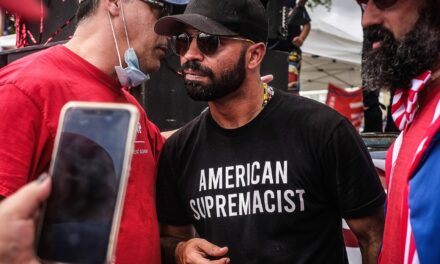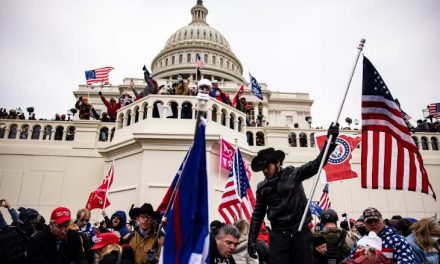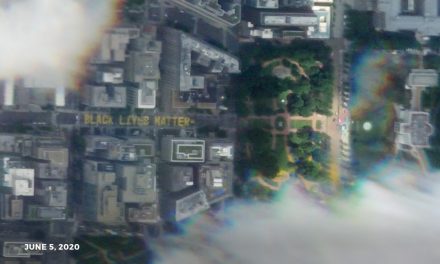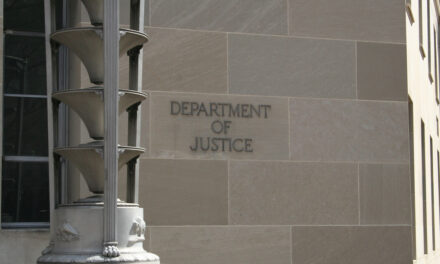
The above image of a woman crying is that of Daniele Watts, an actress in the film Django Unchained, being detained and handcuffed by Studio City LAPD officers on suspicion that she had engaged in an act of prostitution with her white husband, Brian James Lucas, on September 2, 2014. After eventually being released, a month later she and her husband were charged with committing “misdemeanor lewd conduct.” The police officers who detained Ms. Watts on September 2nd did not personally witness any of the alleged “indecent acts” that form the basis for the couple’s indictment. When they arrived on the scene she was standing on the sidewalk. Watts suffered cuts to her wrist from the handcuffs after being thrown into a cop car by the police. Her account of the incident can be found here on her Facebook page.
* * *
In the rash of recent police shootings of unarmed African-Americans, many people (well, other than African Americans themselves) have begun to question the rationale for the tremendous discrepancy between rates of Black people shot by police compared to White people. Unfortunately the statistics are incomplete, since many states and counties do not voluntarily provide information on police shootings to the Department of Justice.
What I’d like to do, therefore, is focus on an area where we do have much more data: police stops of blacks as compared to whites. And the data we do have shows in almost every instance that police stop and detain African-Americans at far higher rates than they do White Americans. In addition, the chance of an arrest is quite high for many African-Americans The recent report by the DOJ regarding the Town of Ferguson’s disproportionate arrest rates for black citizens versus whites is one glaring example …
Ferguson, Mo., is a third white, but the crime statistics compiled in the city over the past two years seemed to suggest that only black people were breaking the law. They accounted for 85 percent of traffic stops, 90 percent of tickets and 93 percent of arrests. In cases like jaywalking, which often hinge on police discretion, blacks accounted for 95 percent of all arrests.
… but there are many others just as bad, or worse:
At least 1,581 other police departments across the USA arrest black people at rates even more skewed than in Ferguson, a USA TODAY analysis of arrest records shows. That includes departments in cities as large and diverse as Chicago and San Francisco and in the suburbs that encircle St. Louis, New York and Detroit.
This should have come as no surprise to anyone, for we’ve seen a tidal wave of evidence of the past few years that police officers detain and often frisk African Americans at rates far in excess of detentions of whites. In Boston, an ACLU report claimed that police stop an frisks showed evidence of racial bias against blacks.
Between 2007 and 2010, out of approximately 200,000 encounters that did not result in an arrest, 63 percent of people stopped and frisked by the BPD were African American. Only 24 percent of the city’s population is black.
Additionally, the study found, stop-and-frisk instances were most likely to occur in the minority-dense neighborhoods of Roxbury, Dorchester, and Mattapan.
“These findings are clear evidence of racial bias in BPD policing,” Matthew Segal, legal director of the Massachusetts ACLU, said in a statement.
Similar results were found in studies of the NYPD by the New York Civil Liberites Union during Mayor Bloomberg’s tenure in office, when the notorious “stop and frisk” policing policy was in effect:
An analysis by the NYCLU revealed that innocent New Yorkers have been subjected to police stops and street interrogations more than 5 million times since 2002, and that black and Latino communities continue to be the overwhelming target of these tactics. Nearly nine out of 10 stopped-and-frisked New Yorkers have been completely innocent, according to the NYPD’s own reports …
On average, black residents of New York City were detained by the police at a rate roughly five times as often as whites, and when Latino Americans are added to the totals, those two groups collectively accounted for well over 80 percent of all stops by the NYPD. Whites who were stopped during the years 2003-2014 never accounted for more than 12% of all stops, and on average accounted for less than 11% of all stops. Whites make up a plurality of the residential population in New York (around 45%), and during the daytime, when workers who commute to work are considered, likely a majority, with blacks at around 25%. Yet, despite this fact, and the vast discrepancy between the races when it comes to the sheer volume of stop and frisk detentions by the cops, whites detained by the police in NYC were far more likely to be found with a weapon or “contraband” (i.e., drugs) on them then were minorities.
• The likelihood a stop of an African American New Yorker yielded a weapon was half that of white New Yorkers stopped. The NYPD uncovered a weapon in one out every 49 stops of white New Yorkers. By contrast, it took the Department 71 stops of Latinos and 93 stops of African Americans to find a weapon.
• The likelihood a stop of an African American New Yorker yielded contraband was one-third less than that of white New Yorkers stopped. The NYPD uncovered contraband in one out every 43 stops of white New Yorkers. By contrast, it took the Department 57 stops of Latinos and 61 stops of African Americans to find contraband.
The same is true of other cities across America: Chicago; San Diego; Miami; and everywhere in between from Dearborn, Michigan to Madison, Wisconsin to that hotbed of leftists, Berkeley, California.
At least 70 departments scattered from Connecticut to California arrested black people at a rate 10 times higher than people who are not black, USA TODAY found. […]
Deep disparities show up even in progressive university towns. USA TODAY found police in Berkeley, Calif., and Madison, Wis., arrested black people at a rate more than nine times higher than members of other racial groups. […]
Arrest rates are lopsided almost everywhere. Only 173 of the 3,538 police departments USA TODAY examined arrested black people at a rate equal to or lower than other racial groups.
At this point, one has to question what makes it more “reasonable” for police to detain and frisk so many African Americans and Latinos, especially since whites, are stopped so much less, and yet are as likely (or in the case of New York, much more likely) to be engaged in criminal activity.
Before proceeding further, however, lets take a look at the legal standard a police officer is required to meet before he or she can lawfully detain anyone, whether you are white, black, brown or an extra-terrestrial life form. Please follow me below the fold for a discussion of the legal standard and why I contend it is being misapplied, intentionally or unconsciously, to target African Americans and other minorities by the law enforcement community, thanks in part to decisions made by the Roberts’ Court.
(cont.)
Most of us have heard of the term “probable cause” because any law enforcement official (“LEO”) must show probable cause before a person can be arrested, either before receiving a warrant from a judicial authority to arrest a person or search their home or that must be shown afterward to justify a search or arrest without a warrant. In brief, the LEO must show knowledge of facts, evidence and circumstances that would lead a reasonable person to conclude a crime has been committed by the person arrested, or that evidence of a crime will be obtained by a search of the suspect’s property or person.
The standard merely to stop and detain someone, however, is far easier to meet. That standard is referred to as “Reasonable Suspicion.” I know, that sound pretty vague. Reasonable suspicion of what? And what constitutes a reasonable versus an unreasonable suspicion on the part of a police officer. The Supreme Court of the Unite States (“SCOTUS”) first established the basis of the reasonable suspicion standard in the 1968 case of Terry v. Ohio.
In the view of the Terry majority, a police officer may stop and detain an individual he or she suspects may have committed (or is about to commit) a punishable crime without violating the Fourth Amendment provide that “in justifying the particular intrusion the police officer must be able to point to specific and articulable facts which, taken together with rational inferences from those facts, reasonably warrant [stopping and detaining a person].” This reasonable suspicion must not be based on an “inchoate hunch” but must be based on what a reasonable police officer would do. Subsequent case law by SCOTUS established that this suspicion must be associated with a specific individual in Ybarra v. Illinois, where a patron of a tavern was detained and searched by police even though the police merely had a warrant to search the building and no independent foundation for suspecting the defendant of any crime.
However, to fully understand how the current Roberts’ Court views the issue, we must look at its decision Arizona v. Johnson where it expanded the scope of the reasonable suspicion standard in Terry in a case involving an passenger in a vehicle stopped by police for a minor traffic offense. The defendant was only a passenger, but this did not stop the court from concluding he could be detained and frisked.
The police, all of whom were members of a “gang task force” began to question the defendant, and he answered all their questions, including telling the officer who made the stop that he lived in a town “associated with the Crips gang and had previously been imprisoned for one year for burglary. When a female police officer demanded he exit the vehicle for further questioning about his possible gang involvement, the defendant willingly complied. (As an aside, this was probably a smart move on his part, all things considered, since police around the country have shown a marked intolerance, and a tendency to resort to force, when a person shows any sign of non-compliance with their demands.) The police officer contended that his answers to her questions gave her a reason to reasonably suspect he was armed with a weapon, and she frisked him moments after he exited the car. She found a gun on him and he was convicted of unlawful possession.
He appealed his conviction on the basis that the police had no just cause to search him. The state of Arizona argued that his own “admissions” following questioning about matters unrelated to the initial traffic stop authorized the cops to pull him out of the car and frisk him based on their reasonable suspicion he was armed. The state appellate court overturned his conviction, holding that that the police officer had no “reason to believe the defendant was engaged in criminal activity” and thus the officer did not have reasonable suspicion to detain and frisk the defendant.
SCOTUS took the case on appeal by the State of Arizona. In an unanimous decision (yes all the “liberals” voted with the majority), SCOTUS voted to overturn the decision of the Arizona Court of Appeals. All nine justices held that even if the original justification for the vehicular stop did not involve the defendant personally, as he was merely a passenger in the rear seat of the car, police could still detain and frisk him, as once a vehicle is stopped for any reason, all person inside the vehicle are effectively detained and are not free to leave. I’ll highlight the most relevant portion of the opinion:
This case concerns the authority of police officers to “stop and frisk” a passenger in a motor vehicle temporarily seized upon police detection of a traffic infraction. In … Terry v. Ohio, 392 U. S. 1 (1968) … [t]he Court upheld “stop and frisk” as constitutionally permissible if two conditions are met. First, the investigatory stop must be lawful. That requirement is met in an on-the-street encounter, Terry determined, when the police officer reasonably suspects that the person apprehended is committing or has committed a criminal offense. Second, to proceed from a stop to a frisk, the police officer must reasonably suspect that the person stopped is armed and dangerous.
For the duration of a traffic stop, we recently confirmed, a police officer effectively seizes “everyone in the vehicle,” the driver and all passengers. Brendlin v. California, 551 U. S. 249, 255 (2007). Accordingly, we hold that, in a traffic-stop setting, the first Terry condition–a lawful investigatory stop–is met whenever it is lawful for police to detain an automobile and its occupants pending inquiry into a vehicular violation. The police need not have, in addition, cause to believe any occupant of the vehicle is involved in criminal activity. To justify a patdown of the driver or a passenger during a traffic stop, however, just as in the case of a pedestrian reasonably suspected of criminal activity, the police must harbor reasonable suspicion that the person subjected to the frisk is armed and dangerous. […]
A lawful roadside stop begins when a vehicle is pulled over for investigation of a traffic violation. The temporary seizure of driver and passengers ordinarily continues, and remains reasonable, for the duration of the stop. Normally, the stop ends when the police have no further need to control the scene, and inform the driver and passengers they are free to leave. See Brendlin, 551 U. S., at 258. An officer’s inquiries into matters unrelated to the justification for the traffic stop, this Court has made plain, do not convert the encounter into something other than a lawful seizure, so long as those inquiries do not measurably extend the duration of the stop. […]
[Police offficer] Trevizo noticed that, as the police approached, Johnson [i.e., the defendant] looked back and kept his eyes on the officers. Id., at 12. When she drew near, she observed that Johnson was wearing clothing, including a blue bandana, that she considered consistent with Crips membership. Id., at 17. She also noticed a scanner in Johnson’s jacket pocket, which “struck [her] as highly unusual and cause [for] concern,” because “most people” would not carry around a scanner that way “unless they’re going to be involved in some kind of criminal activity or [are] going to try to evade the police by listening to the scanner.” Id., at 16. In response to Trevizo’s questions, Johnson provided his name and date of birth but said he had no identification with him. He volunteered that he was from Eloy, Arizona, a place Trevizo knew was home to a Crips gang. Johnson further told Trevizo that he had served time in prison for burglary and had been out for about a year. […]
… Officer Trevizo surely was not constitutionally required to give Johnson an opportunity to depart the scene after he exited the vehicle without first ensuring that, in so doing, she was not permitting a dangerous person to get behind her.
In effect, the Roberts’ Court effectively gutted the requirement in Terry that the police have “articuable facts” and rational inferences that could be drawn from those facts that the defendant was engaged in any criminal activity in order to justify detaining and frisking a person who is merely a passenger in a car stopped for a minor traffic violation. In my view, the fact that the defendant lived in a town associated with gang activity or that he had served a sentence for burglary does not automatically lead to the rational inference that he was armed.
At no point in the traffic stop in the Arizona case did the police see a weapon on the defendant or any visual evidence that he harbored a concealed weapon on his person. He complied with all their demands, and they frisked him automatically – literally within seconds of his peaceful departure from the car. And in the view of nine justices, including the author of the opinion, Ruth Bader Ginsberg, their detention of him and search of his body was lawful and reasonable, and did not violate the terms of the Fourth Amendment.
What’s most shocking, is that Justice Ginsberg’s opinion did not even address the issue of whether it was reasonable to search the defendant for a weapon. The only thing her opinion stated on that issue was that the defendant had no reason to believe he could depart the scene prior to the police officer frisking him to ensure her own safety. Of course, the defendant never attempted to leave the scene. And though Justice Ginsberg describes the testimony given by the arresting officer for suspecting the defendant was “engaged in criminal activity,” her opinion does not address whether those observations and “inferences” met the standard for providing the police officer a reasonable suspicion that the defendant was engaged in criminal activity, much less that he was armed.
Aside from the individual facts of the case, however, the Court’s opinion opens the door to detain individuals in traffic stops for an indefinite period of time, question everyone in the car on matters not related to the initial traffic stop, and require anyone to be frisked merely on the basis of where they might live, their past criminal record and whether they might have “intelligence” about “gang activity” or any other alleged criminal activity of which the people detained may conceivably have knowledge.
Worse still, it effectively makes racial profiling by police extremely easy to get away with. The reasonable suspicion standard necessary to frisk a person after a stop (and we know police can always manufacture a reason to stop a black man or woman if they are in a place they aren’t supposed to be – just ask Harvard Professor Henry Louis Gates) has been ground down to the point any officer can be reasonably justified of suspecting criminal activity on the basis that the suspected person is dressed a certain way, lives in the wrong part of town, or has a past criminal record.
All the cop has to say is that you acted nervously (and who does not feel nervous when stopped by the police, even white males such as myself?), and despite your full compliance with everything the cop demands, you may still be detained, frisked, and even arrested on some trumped up charge. Naturally, that risk is highest among members of minority communities, most prominently African Americans, of course, but also Latinos, LGBT people and those with mental disorders, disabilities, or even political activists.
Is it any wonder that the Ferguson Police Department, and countless police departments around the country, target African American communities, either to generate income or out of sheer racial animus? There is certainly nothing in the SCOTUS Fourth amendment decisions by the Roberts’ Court, many of them listed in Justice Ginsberg’s opinion in Arizona v. Johnson, to discourage disparity in police treatment of African-Americans. If anything, decisions such as Arizona v. Johnson have allowed officers and/or their superiors to believe they can manufacture the flimsiest of excuses to stop and frisk people, in their cars or on the streets, without regard to any consequences.
In essence, black people in America can be, and often are considered by the police as criminal suspects simply because of the melanin content of their skin, and those suspicions are more, not less, likely to be deemed “reasonable” by the courts these days. We may have laws on the books that prohibit discrimination and the violation of civil rights based on race, but those laws are increasingly becoming nothing more than a mere fig leaf to cover the obscene injustice that is being perpetrated upon black people by our so-called justice system.
If you are an African American member of this blog community, you already know this to be true, either through your own personal experiences or from the experiences of family, friends and neighbors. Sadly, not even the most liberal members of SCOTUS are willing to protect you from these ongoing abuses by the police. Indeed, I argue that the decisions by the Roberts’ Court have eliminated many of the legal safeguards prior courts extended to black people, while expanding the ability of the police to act with impunity and at the end of the day have their conduct declared legal regardless of the consequences to the people they harm.
While the law my claim that police cannot act against African Americans solely on the basis of their race, the sad truth is that the de facto situation in America is a person with dark skin who encounters a police officer is far too often reflexively assumed to be a criminal suspect. And those suspicions will far too often be held to be “reasonable” after the fact by far too many judges at both the trial and appellate levels.
It’s my hope that you takeaway at least this one fact about our current racial divisiveness: It’s not going to be solved by any action taken by the Supreme Court, or any court for that matter. Indeed, anyone looking to the judiciary to rectify this situation is sadly misguided. The days of the Warren Court are long gone. The courts at every level are full of conservatives judges, many of them older white men of high status. The ranks of minorities among them are thin, to say the least, both at the state and federal level:
As of early August 2009, 70 percent of federal judges were white men, 15 percent were white women, 10 percent were minority (African-American and Hispanic) males, and 3 percent were minority females.
Obama may have improved that somewhat in his appointments to the Federal Circuit Courts, but a Republican President could change that dynamic in a heartbeat. Furthermore, Republicans dominate many state courts, and conservative billionaires are doing their best to support that effort. I don’t see the courts acting to reversing the trend of the police targeting black people for detention and arrest anytime soon.
In short, the cops don’t need a reason to stop black people on the street or in their cars, other than the simple fact that they are not white. And this practice will continue in this country as long as we – and here I am talking to white people in particular – fail to make this an major national issue that must be addressed by our politicians, by the leaders of our local police forces and by the media.
Right now, a growing number courageous black youth (and their supporters among some whites) are attempting to reinvent the Civil Right Movement with Black Lives Matters and other organized attempts to bring this country face to face with the ever resilient racism in our institutions, both private and public, and among far too many white Americans, who would like to believe the myth that all this was resolved by Martin Luther King getting his name on a holiday. Regrettably, though, with a few exceptions, the major media outlets are either ignoring the movement, or in the case of conservative media, actively disparaging and demonizing it.
Our upper-crust elites and institutions are not going to offer any top-down solution to the crisis of our nation’s systemic and societal racism. No, this will have to be a bottom-up, grass roots effort by all people of good will from every race, ethnicity, religion (or non-religion), gender, et alia, to bring about the change we need. You can start by going to the Black Lives Matter website and seeing what you can do to help in whatever way you can this effort.
Black Lives Matter Facebook Page
and Black Lives Matter Twitter
Thank you
Steve







